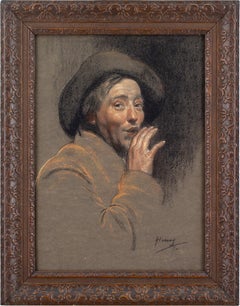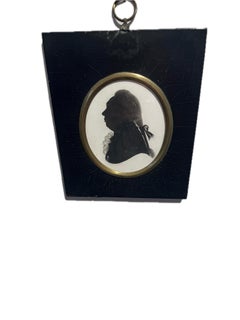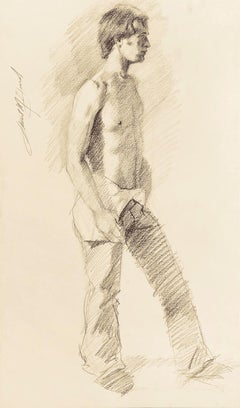Herbert Johnson Harvey Art
to
2
2
2
1
1
Overall Height
to
Overall Width
to
2
2
2
1
2
1
2
6,952
3,302
2,514
1,213
1
1
1
1
Artist: Herbert Johnson Harvey
Herbert Johnson Harvey, The Whisper, Self-Portrait, Pastel
By Herbert Johnson Harvey
Located in Cheltenham, GB
This early 20th-century pastel by Herbert Johnson Harvey (1884-1928) depicts the artist dressed in traditional peasant clothing while surreptitiously whispering.
Harvey carried an a...
Category
1920s English School Herbert Johnson Harvey Art
Materials
Pastel, Paper
Reverie - Early 20th Century British chalk drawing of a girl by H J Harvey
By Herbert Johnson Harvey
Located in London, GB
HERBERT JOHNSON HARVEY
(British 1883-1956)
Reverie
Signed with monogram and dated l.l.: HJ 09
Red chalks
Framed
29.5 by 22 cm., 11 ¾ by 8 ¾ in.
(fra...
Category
Early 20th Century Realist Herbert Johnson Harvey Art
Materials
Chalk
Related Items
John Miers late 18th Century Georgian English silhouette portrait
Located in Harkstead, GB
A very finely detailed silhouette in very good condition by one of the truly great silhouette artists of the Georgian period.
John Miers (1758-1821)
Portrait of a gentleman, profile...
Category
Late 18th Century English School Herbert Johnson Harvey Art
Materials
Plaster, Watercolor
Free Shipping
H 3 in W 2.5 in D 0.5 in
Untitled (Man Undressing)
By Mark Beard
Located in New York, NY
Graphite on paper
Signed, c.l.
This artwork is offered by ClampArt, located in New York City.
Mark Beard, born in 1956 in Salt Lake City, now live...
Category
1970s Realist Herbert Johnson Harvey Art
Materials
Paper, Graphite
Frederick Frith mid 19th Century English Victorian silhouette portrait
Located in Harkstead, GB
A finely detailed silhouette of a Victorian clergyman.
Frederick Frith (1819-1871)
The Reverend James Metze, bust length, turned to the right, wearing coat and cravat
Inscribed to t...
Category
Mid-19th Century English School Herbert Johnson Harvey Art
Materials
Watercolor, Paper
Free Shipping
H 2.75 in W 2.25 in D 0.5 in
Untitled (Man Reclining on Tile Floor)
By Mark Beard
Located in New York, NY
Graphite and conté crayon on paper
Signed and dated, l.r.
This artwork is offered by ClampArt, located in New York City.
Mark Beard, born in 1956 in Salt Lake City, now lives in Ne...
Category
1970s Realist Herbert Johnson Harvey Art
Materials
Paper, Graphite, Conté
English school, circa 1784 'Mr and Mrs Rogers', pastel on paper, a pair
Located in Petworth, West Sussex
A wonderful naive pair of 18th Century portraits of Mr and Mrs Rogers, (A pair).
The details are:
English school, circa 1784
Mr and Mrs Rogers
Pastel on paper
Inscribed with sitter...
Category
18th Century English School Herbert Johnson Harvey Art
Materials
Paper, Pastel
H 26.5 in W 19.38 in D 1 in
Two Men
By Mark Beard
Located in New York, NY
Charcoal with red and white conté crayon on Rives BFK paper
Signed in pencil, l.l.
This artwork is offered by ClampArt, located in New York City.
Mark Beard, born in 1956 in Salt L...
Category
21st Century and Contemporary Realist Herbert Johnson Harvey Art
Materials
Conté, Paper, Charcoal
Untitled (Man Reading Newspaper)
By Mark Beard
Located in New York, NY
Conté crayon on paper
Signed, l.r.
This artwork is offered by ClampArt, located in New York City.
Mark Beard, born in 1956 in Salt Lake City, now lives in New York City. His works ...
Category
1970s Realist Herbert Johnson Harvey Art
Materials
Conté, Paper
Sketch of a head - Carved in stone -
Located in Berlin, DE
Emil Faesch (1865 Basel - 1915 Basel). Sketch of a head. Charcoal on painting cardboard, 60 x 47.5 cm (folio size), signed and dated at lower right "E. Faesch. 1888.".
Minor browning.
- Carved in stone -
About the artwork
The life-size head has an immensely present presence. This effect is due to the fact that Faesch took his cue from academic classical...
Category
1880s Realist Herbert Johnson Harvey Art
Materials
Chalk
19th century English chalk drawing on paper of a Lions head
By William Huggins
Located in Woodbury, CT
William Huggins was born in Liverpool, England on the 13th of May, 1820. His parents were Samuel and Elisabeth Huggins. He took his first drawing lessons from the Liverpool Mechanics...
Category
1840s Victorian Herbert Johnson Harvey Art
Materials
Pastel, Paper
Free Shipping
H 11.75 in W 10 in
Untitled (Man in Repose Leaning Against Post)
By Mark Beard
Located in New York, NY
Conté crayon on paper
Signed and dated, l.r.
This artwork is offered by ClampArt, located in New York City.
Mark Beard, born in 1956 in Salt Lake City, now lives in New York City. ...
Category
1970s Realist Herbert Johnson Harvey Art
Materials
Conté, Paper
Modern Realistic Black and White Pencil Drawing Study of Smiling Mouths and Lips
Located in Houston, TX
Modern realistic black and white pencil drawing study by American artist Scott Martin. The work features six meticulously rendered studi...
Category
20th Century Realist Herbert Johnson Harvey Art
Materials
Pencil, Paper
Rare Modernist Hungarian Rabbi Pastel Drawing Gouache Painting Judaica Art Deco
By Hugó Scheiber
Located in Surfside, FL
Rabbi in the synagogue at prayer wearing tallit and tefillin.
Hugó Scheiber (born 29 September 1873 in Budapest – died there 7 March 1950) was a Hungarian modernist painter.
Hugo Scheiber was brought from Budapest to Vienna at the age of eight where his father worked as a sign painter for the Prater Theater. At fifteen, he returned with his family to Budapest and began working during the day to help support them and attending painting classes at the School of Design in the evening, where Henrik Papp was one of his teachers. He completed his studies in 1900. His work was at first in a post-Impressionistic style but from 1910 onward showed his increasing interest in German Expressionism and Futurism. This made it of little interest to the conservative Hungarian art establishment.
However, in 1915 he met the great Italian avant-gardist Filippo Tommaso Marinetti and the two painters became close friends. Marinetti invited him to join the Futurist Movement. The uniquely modernist style that he developed was, however, closer to German Expressionism than to Futurism and eventually drifted toward an international art deco manner similar to Erté's. In 1919, he and his friend Béla Kádar held an exhibition at the Hevesy Salon in Vienna. It was a great success and at last caused the Budapest Art Museum to acquire some of Scheiber's drawings. Encouraged, Scheiber came back to live in Vienna in 1920.
A turning point in Scheiber's career came a year later, when Herwarth Walden, founder of Germany's leading avant-garde periodical, Der Sturm, and of the Sturm Gallery in Berlin, became interested in Scheiber's work. Scheiber moved to Berlin in 1922, and his paintings soon appeared regularly in Walden's magazine and elsewhere. Exhibitions of his work followed in London, Rome, La Paz, and New York.
Scheiber's move to Germany coincided with a significant exodus of Hungarian artists to Berlin, including Laszlo Moholy-Nagy and Sandor Bortnyik. There had been a major split in ideology among the Hungarian avant-garde. The Constructivist and leader of the Hungarian avantgarde, Lajos Kassák (painted by Hugó Scheiber in 1930) believed that art should relate to all the needs of contemporary humankind. Thus he refused to compromise the purity of his style to reflect the demands of either the ruling class or socialists and communists. The other camp believed that an artist should be a figurehead for social and political change.
The fall out and factions that resulted from this politicisation resulted in most of the Hungarian avant gardists leaving Vienna for Berlin. Hungarian émigrés made up one of the largest minority groups in the German capital and the influx of their painters had a significant effect on Hungarian and international art. Another turning point of Scheiber's career came in 1926, with the New York exhibition of the Société Anonyme, organized by Katherine Dreier. Scheiber and other important avant garde artists from more than twenty-three countries were represented. In 1933, Scheiber was invited by Marinetti to participate in the great meeting of the Futurists held in Rome in late April 1933, Mostra Nazionale d’Arte Futurista where he was received with great enthusiasm. Gradually, the Hungarian artists began to return home, particularly with the rise of Nazism in Germany. Kádar went back from Berlin in about 1932 and Scheiber followed in 1934.
He was then at the peak of his powers and had a special flair in depicting café and cabaret life in vivid colors, sturdily abstracted forms and spontaneous brush strokes. Scheiber depicted cosmopolitan modern life using stylized shapes and expressive colors. His preferred subjects were cabaret and street scenes, jazz musicians, flappers, and a series of self-portraits (usually with a cigar). his principal media being gouache and oil. He was a member of the prestigious New Society of Artists (KUT—Képzőművészek Új Társasága)and seems to have weathered Hungary's post–World War II transition to state-communism without difficulty. He continued to be well regarded, eventually even receiving the posthumous honor of having one of his images used for a Russian Soviet postage stamp (see image above). Hugó Scheiber died in Budapest in 1950.
Paintings by Hugó Scheiber form part of permanent museum collections in Budapest (Hungarian National Museum), Pecs (Jannus Pannonius Museum), Vienna, New York, Bern and elsewhere. His work has also been shown in many important exhibitions, including:
"The Nell Walden Collection," Kunsthaus Zürich (1945)
"Collection of the Société Anonyme," Yale University Art Gallery, New Haven, Connecticut (1950)
"Hugó Scheiber: A Commemorative Exhibition," Hungarian National Museum, Budapest (1964)
"Ungarische Avantgarde," Galleria del Levante, Munich (1971)
"Paris-Berlin 1900-1930," Centre Georges Pompidou, Paris (1978)
"L’Art en Hongrie, 1905-1920," Musée d’Art et l’Industrie, Saint-Etienne (1980)
"Ungarische Avantgarde in der Weimarer Republik," Marburg (1986)
"Modernizmus," Eresz & Maklary Gallery, Budapest (2006)
"Hugó Scheiber & Béla Kádár," Galerie le Minotaure, Paris and Tel Aviv (2007)
Hugó Scheiber's paintings continue to be regularly sold at Sotheby's, Christie's, Gillen's Arts (London), Papillon Gallery (Los Angeles) and other auction houses.
He was included in the exhibition The Art Of Modern Hungary 1931 and other exhibitions along with Vilmos Novak Aba, Count Julius Batthyany, Pal Bor, Bela Buky, Denes Csanky, Istvan Csok, Bela Czobel, Peter Di Gabor, Bela Ivanyi Grunwald, Baron Ferenc Hatvany, Lipot Herman, Odon Marffy, C. Pal Molnar...
Category
Early 20th Century Modern Herbert Johnson Harvey Art
Materials
Paper, Charcoal, Pastel, Watercolor, Gouache
Herbert Johnson Harvey art for sale on 1stDibs.
Find a wide variety of authentic Herbert Johnson Harvey art available for sale on 1stDibs. You can also browse by medium to find art by Herbert Johnson Harvey in chalk, crayon, paper and more. Not every interior allows for large Herbert Johnson Harvey art, so small editions measuring 9 inches across are available. Customers who are interested in this artist might also find the work of John Sergeant, William Edward Frost, and Oliver Messel. Herbert Johnson Harvey art prices can differ depending upon medium, time period and other attributes. On 1stDibs, the price for these items starts at $1,402 and tops out at $3,568, while the average work can sell for $2,485.
Artists Similar to Herbert Johnson Harvey
Robert Sargent Austin, R.A., P.R.E., P.R.W.S.



